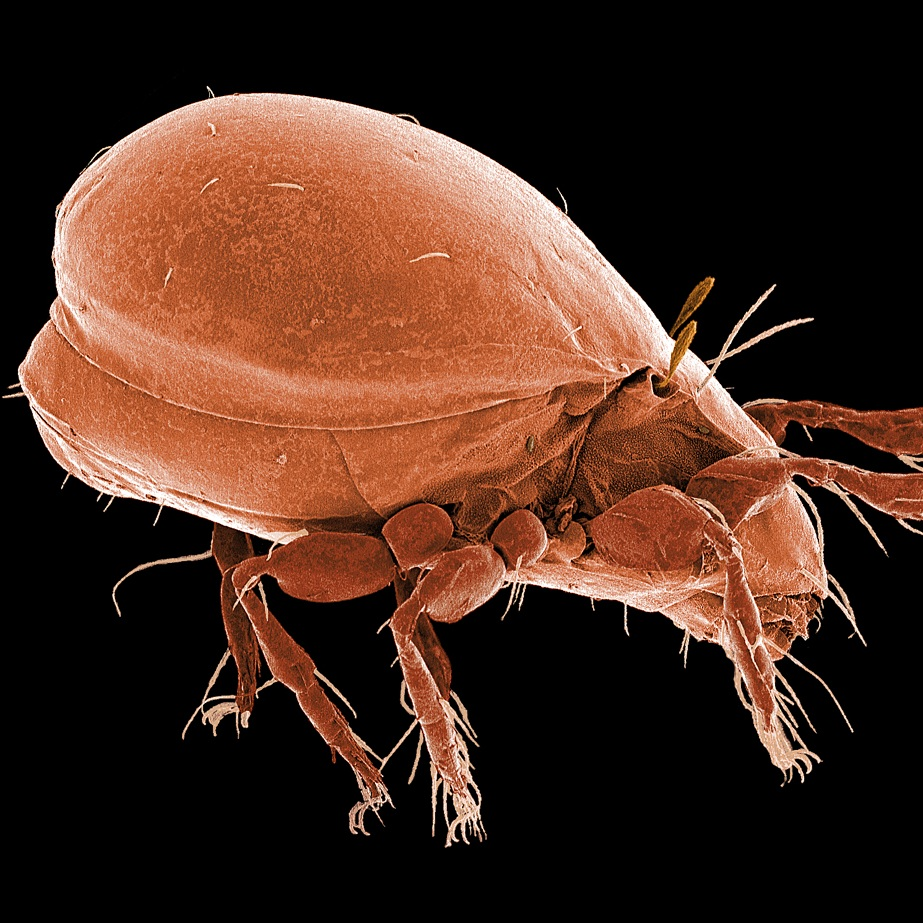If I asked you to name the strongest animal on Earth, you’d probably think of something huge and powerful like an elephant, lion, or even a bear, right? But what if I told you there’s an animal smaller than a grain of sand that can put all these mighty creatures to shame? Sounds unbelievable, doesn’t it? Well, believe it or not, it’s absolutely true! Meet the oribatid mite—a microscopic powerhouse that lifts loads that would crush even the strongest humans.
Let’s dive deeper into this tiny yet incredibly strong creature and discover exactly how it manages such amazing feats.
Meet the World’s Strongest Animal: The Oribatid Mite

Oribatid mites aren’t exactly celebrities in the animal kingdom. You probably haven’t even heard of them before today. These tiny creatures weigh less than 25 micrograms—that’s smaller and lighter than the grains of sand you casually brush off your hands at the beach. Yet, despite their minuscule size, oribatid mites pack a muscular punch that’s simply extraordinary.
Scientists have observed these microscopic creatures lifting objects up to 1,180 times their own body weight. To put this into perspective, imagine if you could lift a massive cargo ship or about 82 tons. Sounds impossible, doesn’t it? But that’s exactly the kind of strength oribatid mites exhibit daily. It’s an awe-inspiring example of nature’s hidden wonders.
Why Are Oribatid Mites So Amazingly Strong?
You might wonder, how is it even possible for something so tiny to achieve strength on this superhuman level? Well, it all boils down to some fascinating biology and physics working hand-in-hand.
Video : Meet the Tiny Mite That’s Stronger Than Superman
Incredible Muscle-to-Body Ratio
One reason oribatid mites are freakishly strong is due to their unique muscle-to-body-weight ratio. Because they don’t have heavy internal skeletons like humans or elephants, their bodies can pack in a higher percentage of pure muscle. Think of it this way: imagine a weightlifter who’s all muscle and no extra fat—that’s essentially what an oribatid mite is like, just on an incredibly microscopic scale.
The Advantage of Their Small Size
Additionally, their tiny size contributes massively to their strength. Oribatid mites have a large surface-area-to-volume ratio. This ratio allows their muscles to operate more efficiently with significantly less energy waste. Simply put, their small muscles expend far less energy moving their lightweight bodies around. The result? Extra strength to spare for lifting and carrying heavier objects.
No Internal Skeleton Means Less Weight, More Strength
Here’s another fascinating fact: oribatid mites, like most insects and arthropods, possess an external skeleton (exoskeleton) rather than internal bones. This exoskeleton provides strength and protection without the heaviness associated with internal bones. Less internal weight means more muscle space, translating directly into incredible lifting power.
Habitat and Life of the Mighty Oribatid Mite
Now, you might be curious—where exactly do these tiny champions live? Surprisingly, oribatid mites are incredibly common. In fact, they dominate many forest floors and soil ecosystems worldwide. Hidden among decaying leaves, organic matter, and damp soil, oribatid mites quietly play essential roles in maintaining ecological balance.

Beneficial Contributions to Ecosystems
Oribatids aren’t just impressive weightlifters—they’re environmental heroes too. These mites actively improve soil quality by aiding seed dispersal, breaking down organic matter, and controlling populations of harmful parasites and insect pathogens. By keeping soils healthy, they indirectly support plant growth, animal health, and even human agriculture.
Slow Growth but Long Evolutionary History
Despite their impressive strength, oribatid mites live life at a leisurely pace. They have low metabolic rates, grow slowly, and take anywhere from a few months to two full years to mature from egg to adulthood. Interestingly, their life cycle is remarkably complex, going through six distinct developmental stages—pre-larval, larval, three pupal stages, and finally adulthood.
And here’s something even more incredible: these tiny mites have likely roamed Earth’s soils for 300 to 400 million years. That means oribatids have outlasted dinosaurs, ice ages, and countless other species, quietly thriving and evolving beneath our feet.
What Can We Learn from Oribatid Mites?
Beyond their awe-inspiring strength and resilience, oribatid mites offer us powerful lessons about adaptation and efficiency. They demonstrate vividly that size doesn’t always correlate with power or importance. Their success in nature results from perfect adaptations to their environment, optimized anatomy, and the efficiency of their muscles.
Video : Oribatid mite (Acari: Cryptostigmata) from soil at Ibaraki Prefecture, Japan
Think about it—what if humans could mimic even a fraction of this efficiency? We’re always looking to build stronger yet lighter materials, more powerful yet smaller machinery. The oribatid mite, tiny as it is, might just provide inspiration for future advancements in technology, engineering, and biomechanics.
Conclusion: Celebrating the Tiny Giant of the Animal World
So, the next time you think about powerful creatures, don’t limit yourself to elephants, gorillas, or lions. Remember the astonishing oribatid mite, a tiny animal no bigger than a grain of sand, capable of lifting unimaginable weight relative to its body size.
These mites remind us vividly that power isn’t always about size or strength that you can easily see. Sometimes, real strength is hidden in the smallest creatures on Earth, patiently living beneath our notice. Isn’t that fascinating? Nature truly never stops surprising us.
From their exceptional strength to their important ecological roles, oribatid mites are remarkable creatures deserving more recognition. Let’s celebrate these tiny yet powerful champions that teach us valuable lessons about strength, efficiency, and adaptation.
Next time you stroll through a forest, take a moment to consider the microscopic miracles happening beneath your feet—you just might be walking above the strongest animals on the planet!
My little son kept saying a ghost followed him. What I discovered next changed our lives

Lately, our little boy Hudson has changed. He used to be a bundle of joy, always laughing and playing, but now, he’s been crying non-stop, scared of everything, and even started to stutter. He kept saying a ghost was following him at home. It really freaked me out, so I wanted to take his mind off those spooky thoughts.
A Frightening Encounter
Last weekend, we went to the children’s room and then out for some ice cream at a local cafe. I was sitting there with Hudson when suddenly, he turned pale upon seeing one of the waitresses. He started shaking and crying, and I was just terrified for him.
“Baby, what’s wrong?” I asked, trying to calm him.
“It’s a ghost…Dad told me,” he whispered, clutching my hand tightly.
“There are no ghosts, baby…”
“This one is real! I saw her in our house a few days ago, but Dad said he’d protect me and…,” Hudson trailed off, his eyes wide with fear.
Unraveling the Mystery
The mention of his father sent chills down my spine. Hudson’s father and I had separated a year ago, and he had visitation rights every weekend. But what could he possibly have told Hudson to make him this terrified? Determined to get to the bottom of this, I decided to have a talk with my ex-husband, James.
When I confronted James, he seemed genuinely surprised and concerned about Hudson’s behavior. “I have no idea what he’s talking about,” he insisted. “I’ve never mentioned any ghosts to him.”

But Hudson’s fear was real, and I knew something was terribly wrong. I decided to investigate further, starting with the waitress at the cafe. Her name was Emily, and she looked about my age, with a kind but sad expression.
“I’m sorry to bother you, but my son seems to be really scared of you. Do you know why that might be?” I asked her.
Emily looked shocked. “I’ve never seen your son before today,” she said, her eyes widening. “I can’t imagine why he’d be afraid of me.”
Dark Revelations
Determined to protect Hudson, I started to dig into James’s past. I discovered that Emily had been a close friend of his in college. They had lost touch over the years, but there was something more sinister in their past. Emily had been involved in a tragic accident that left her in a coma for months. When she woke up, she claimed to have seen spirits and was shunned by many, including James.
“Do you think it’s possible that Hudson might be sensing something…supernatural?” I asked hesitantly.
Emily sighed. “I don’t know. But if he’s seeing something, it might be related to that accident. I never meant to scare him.”
Just then, Hudson’s voice piped up from behind me. “Mommy, she’s the ghost I saw in our house.”
Emily and I exchanged horrified looks. “Hudson, what do you mean?” I asked, my heart pounding.
He explained in his little voice, “I saw her in the living room. She was crying and told me she was sorry.”
Emily’s face went white. “That sounds like me. I used to visit James at his place sometimes. Maybe…I left some part of me there.”



Leave a Reply